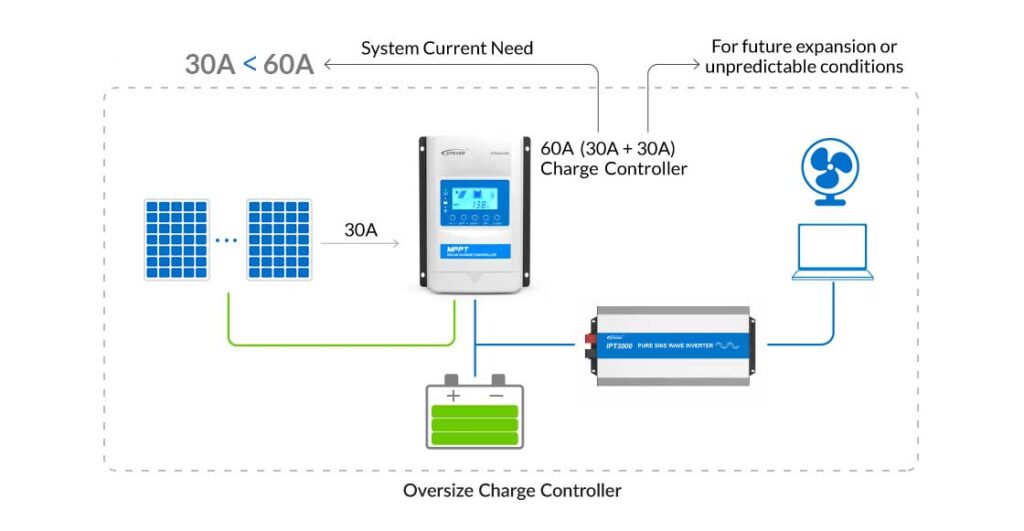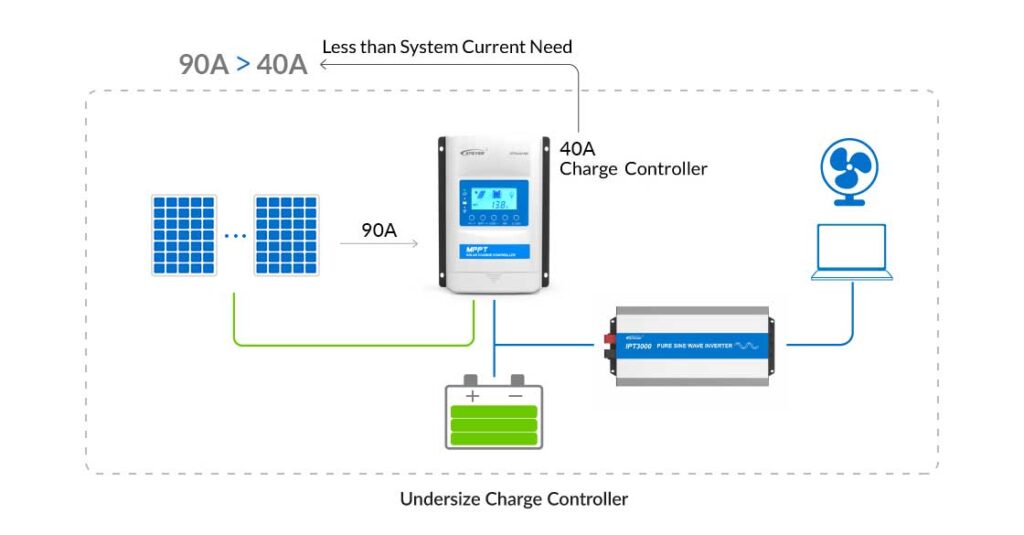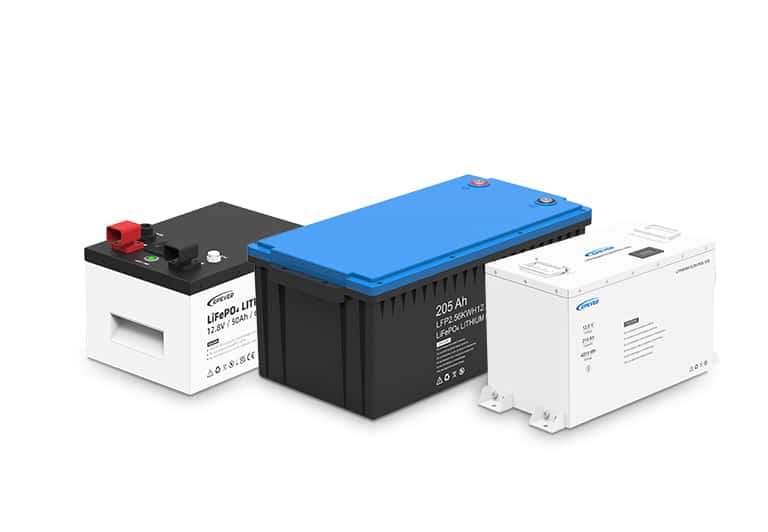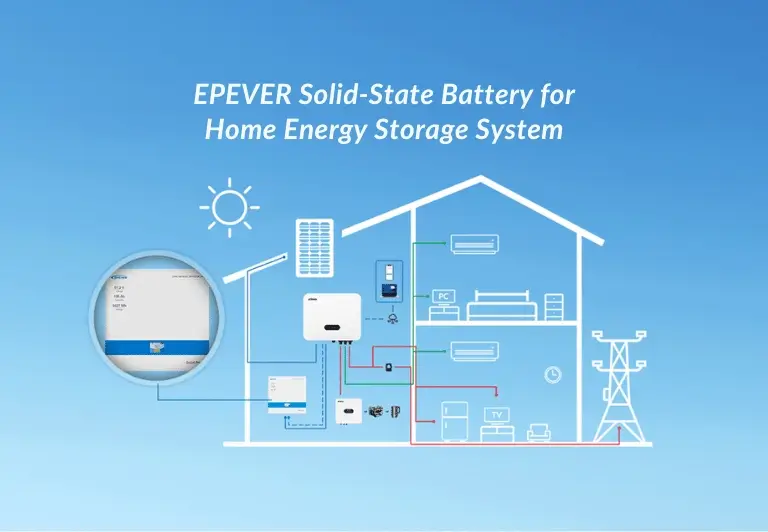How to Size Your Solar Charge Controller and Solar Array?
- 30 April 2025
- 120 views
- No Comments
How to Size Your Solar Charge Controller and Solar Array?
Getting Solar Charge Controller Sizing Right from the Start
When designing a solar energy system, one of the most critical decisions is selecting the right solar charge controller. But questions often arise: Should you pick a larger controller for future expansion? Should you slightly oversize your solar array for better energy capture? Or is it okay to save cost by going smaller?
This guide clears up the confusion about oversizing and undersizing, clearly distinguishing between oversizing the controller and oversizing the solar array, and explains real-world impacts to help you make a system choice that’s reliable, efficient, and future-proof.

What Does Oversizing the Solar Charge Controller Mean?
In this article, “oversizing the controller” specifically refers to choosing a charge controller with a higher current rating than your solar system currently requires — on purpose.
Example:
- Your solar array only needs a 30A controller today.
- Instead, you install a 60A controller.
You are not oversizing the solar panels relative to the controller’s limits here. Instead, you are buying a controller bigger than necessary to add flexibility, safety, and future-proofing to your system.

Good Reasons to Oversize the Solar Charge Controller
- Planning for Future Expansion
If you plan to add more solar panels or batteries later, installing a larger controller now saves the cost and effort of upgrading later.
Example: Starting with a 400W system today but planning to expand to 800W. A 60A controller chosen now avoids future replacement.
- Managing Variable Solar Conditions
In regions with fluctuating sunlight (e.g., deserts or mountains), extra controller headroom prevents shutdowns from sudden current spikes.
Example: A larger controller absorbs occasional surges from stronger-than-expected solar irradiance.
- Reducing Thermal Stress
Controllers operated well below their limits generate less heat, improving system lifespan and reliability.
Example: A 60A controller running at 30A to 40A stays cooler than a 40A controller at 90%-100% load.
- Flexibility for Unknown Future Loads
Off-grid systems often evolve. Extra controller capacity accommodates new appliances without redesign.
Example: Adding a new refrigerator or communication equipment in an RV.

Important Note on Oversizing the Controller
Oversizing must be purposeful. Installing a controller that’s excessively large without need increases system costs without meaningful benefits.
Tip: Always oversize based on clear future plans, environmental needs, or reliability goals — not just “bigger is better.”
What Does Oversizing the Solar Array Mean?
“Oversizing the solar array” means connecting a solar panel array whose total wattage (Pmax) is higher than the controller’s rated maximum input power.
This practice is safe and common when:
- The total Voc(open-circuit voltage) remains below the controller’s maximum voltage rating.
- The total Isc(short-circuit current) remains within the controller’s safe current range.
The controller will limit its output to its rated current, safely “clipping” any extra energy during peak sun hours.
Example of Oversizing the Solar Array
System Setup:
- Controller rated for 500W at 12V.
- Solar array with total installed power = 700W (1.4x the rated power).
Result:
- During peak sunlight, the controller processes up to 500W and clips the rest.
- During low irradiance (morning, evening, cloudy days), the oversized array provides better overall daily harvest.
No damage occurs if voltage and current safety limits are respected.
Why Oversize the Solar Array?
- Boost Energy Capture in Real Conditions
Solar panels rarely operate at their rated output. Oversizing helps maintain stronger performance in non-ideal conditions.
- Offset Poor Panel Orientation or Shading
In suboptimal installations (e.g., east/west facing roofs), larger arrays can compensate for reduced sun hours.
- Increase Return on Investment (ROI)
More energy harvested daily without needing a larger or more expensive controller.
The Impact of Undersizing a Solar Charge Controller
Undersizing the controller happens when the installed controller cannot safely handle the maximum current produced by the solar array.
Example:
- Panels can generate up to 90A.
- A 40A controller is installed.
This mismatch leads to power clipping, controller stress, and possible overheating.
Common Causes of Controller Undersizing:
- Choosing smaller, cheaper hardware to reduce upfront costs.
- Misjudging real-world panel performance.
- Designing without accounting for seasonal or environmental variations.
Risks of Controller Undersizing:
- Energy Loss: Energy is wasted during peak sun.
- Thermal Damage: Continuous operation near or above limits damages components.
- Poor Battery Management: Lithium batteries, in particular, can suffer from unstable charging.

How to Correctly Size a Solar Charge Controller
Real-World Example: Tracer 4210AN Controller + LONGi 440W Panel
Step 1: Identify System Voltage
- Battery voltage: 12V system
- Controller must support: 12V (Tracer 4210AN supports 12V/24V)
Step 2: Review Solar Panel Specs
|
Parameter |
Value |
|
Pmax |
440W |
|
Voc |
39.53V |
|
Isc |
14.3A |
Step 3: Calculate Total PV Input
- Voc = 39.53V
- Isc = 14.3A
- Pmax = 440W
Step 4: Compare to Controller Limits
|
Controller Spec |
Controller Limit |
Panel Value |
Match? |
|
Max PV Power (12V) |
520W |
440W |
OK |
|
Max PV Voc |
100V |
39.53V |
OK |
|
Rated Charging Current |
40A |
14.3A |
OK |
Fully compliant: safe installation.
Why Slight Solar Array Oversizing (up to 1.5×) Is Allowed
Oversizing the solar array up to about 1.5× the controller’s rated input power is industry-accepted because:
- Irradiance can be high:Real-world irradiance can sometimes exceed STC conditions.
- Temperature shifts:Cold weather boosts Voc; hot weather reduces panel voltage and efficiency.
- Minor system losses:Cable losses and panel mismatch reduce effective production.
Reminder: Always stay within controller’s Voc and Isc input limits, even if oversizing Pmax.
When Should You Oversize the Controller or Solar Array?
Good Reasons to Oversize the Controller:
- You anticipate adding more solar panels or battery capacity.
- Your site experiences intense or highly variable sunlight.
- You want the controller to run cooler and last longer.
- Your installation is in a remote or critical location where reliability matters.
Good Reasons to Oversize the Solar Array:
- Panels face east, west, or experience partial shading.
- You want to maximize energy capture across all daylight hours.
Budget constraints prevent using a larger controller, but you want more consistent energy harvest.
When Undersizing a Controller is Dangerous
- If your solar system frequently operates near maximum panel output.
- If your site experiences extreme temperatures that increase panel current.
- If your controller lacks proper thermal protection.
- If you are using lithium batteries requiring stable, high-quality charging.
Final Takeaways
- Undersizing the controller =Efficiency loss + High stress + Reliability risks.
- Oversizing the controller =Safer, cooler, more expandable system.
- Oversizing the solar array =Better overall energy harvest when properly managed.
Always size conservatively, allowing room for future expansion and unexpected conditions.

Why Controller Quality Matters: Spotlight on EPEVER
Choosing the right controller isn’t just about numbers—it’s about ensuring the safety, reliability, and long-term performance of your energy system.
Key Features of EPEVER MPPT Solar Charge Controllers:
- Industry-leading MPPT tracking (≥99.5%) and efficiency (up to 98%)
- Broad battery type support (Lithium, AGM, Gel, Flooded)
- Wide PV voltage range with intelligent temperature compensation
- Scalable design (parallel up to 6 units)
- Advanced communication options: RS485, Bluetooth, Wi-Fi, 4G

Key Features of EPEVER PWM Solar Charge Controllers:
- Affordable for smaller off-grid systems
- Reliable multi-mode load control (manual, timer, light-controlled)
- USB charging outputs (select models)
- Full suite of electronic protections

Final Advice
At EPEVER, we know that sizing a solar charge controller isn’t just a numbers game—it’s about achieving the right balance between safety, system performance, and long-term reliability.
When designing your solar energy system, it’s critical to choose a controller that matches your actual system conditions while leaving room for flexibility. While undersizing might seem more economical initially, it often leads to energy loss, overheating, and premature equipment failure. By contrast, thoughtful oversizing—whether of the controller or the solar array—ensures better performance, greater expansion potential, and smoother operation under variable real-world conditions, provided that voltage and current limits are strictly respected.
Whether you’re building a small off-grid setup or scaling up to a larger installation, selecting the right solar charge controller is essential for maximizing your system’s potential.
Explore EPEVER’s full lineup of MPPT and PWM charge controllers to find the perfect match for your solar project—and power your future with confidence.




